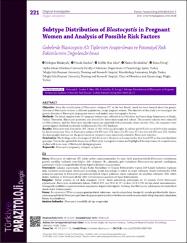| dc.contributor.author | Malatyalı, Erdoğan | |
| dc.contributor.author | Sankur, Funda | |
| dc.contributor.author | Akın, Melike Nur | |
| dc.contributor.author | Ertabaklar, Hatice | |
| dc.contributor.author | Ertuğ, Sema | |
| dc.date.accessioned | 2021-03-01T08:14:51Z | |
| dc.date.available | 2021-03-01T08:14:51Z | |
| dc.date.issued | 2020 | en_US |
| dc.identifier.citation | Malatyalı E, Sankur F, Akın MN, Ertabaklar H, Ertuğ S. Subtype Distribution of Blastocystis in Pregnant Women and Analysis of Possible Risk Factors. Turkiye Parazitol Derg 2020;44(4):221-5. | en_US |
| dc.identifier.other | PMID: 33269564 | |
| dc.identifier.uri | https://hdl.handle.net/20.500.12809/8980 | |
| dc.description.abstract | Objective: Since the identification of Blastocystis subtypes (ST) in the last decade, much has been learned about the genetic diversity of Blastocystis isolates in different populations, except pregnant women. The objective of this study is to investigate the genetic diversity of Blastocystis in pregnant women and analyse some demographic factors.
Methods: The faecal samples from 100 pregnant women were collected at an Obstetrics and Gynecology Department in Muğla, Turkey. Thereafter, Blastocystis positivity was detected by direct microscopy and culture. The positive cultures were subjected to DNA isolation, and the Blastocystis barcode region was amplified with polymerase chain reaction. Next, the sequences were queried against GenBank nucleotide and Blastocystis STs (18S) databases.
Results: Blastocystis was detected in 14% (14 out of 100) of the faecal samples by culture and 10% (10 out of 100) of the samples by direct microscopy. Nine of Blastocystis isolates (64.4%) were ST3, three (21.4%) were ST1 and two (14.2%) were ST2. Neither the demographic features nor the gastrointestinal symptoms were statistically related to Blastocystis infection.
Conclusion: The findings in this study agreed with the most of the previous human studies that found ST3 as the most abundant genotype. This study reported the frequency of Blastocystis in pregnant women and highlighted the importance of comprehensive studies with more cases of Blastocystis during pregnancy. | en_US |
| dc.description.abstract | Amaç: Blastocystis alt tiplerinin (ST) yakın tarihte tanımlanmasından bu yana, farklı popülasyonlarda Blastocystis izolatlarının genetik çeşitliliği hakkında yeni bilgiler elde edilmiştir. Bu çalışmada, gebe kadınlarda Blastocystis’nin genetik çeşitliliğinin araştırması ve bazı demografik faktörlerin değerlendirilmesi amaçlanmıştır.
Yöntemler: Çalışma kapsamında, Muğla Kadın Hastalıkları ve Doğum Bölümü’nden toplam 100 hamile kadından toplanan dışkı örnekleri incelenmiştir. Blastocystis pozitifliği, direkt mikroskopi ve kültür ile tespit edilmiştir. Pozitif kültürlerden DNA izolasyonu yapılmış ve Blastocystis genomunda barkod bölgesi polimeraz zincir reaksiyonu ile amplifiye edilmiştir. Elde edilen diziler, Genbank ve Blastocystis alt tür (18S) veri tabanlarına girilerek alt tipler belirlenmiştir.
Bulgular: Kültür yöntemi ile 14 dışkı örneğinde (%14), direkt mikroskopi yöntemiyle ise 10 örnekte (%10) Blastocystis saptanmıştır. Blastocystis izolatlarının dokuzu (%64,4) ST3, üçü (%21,4) ST1 ve ikisi (%14,2) ST2 alt tipi olarak tanımlanmıştır. Demografik özellikler ve gastrointestinal semptomlar değerlendirildiğinde, herhangi biri Blastocystis enfeksiyonu ile istatistiksel olarak ilişkili bulunmamıştır.
Sonuç: Bu çalışmada ST3’ün en yaygın genotip olarak bulunması, önceki çalışmaların birçoğu ile uyumlu görülmektedir. Ayrıca, çalışmamız gebelerde Blastocystis görülme sıklığını ortaya koymakta ve bu konuda örnek sayısının fazla olduğu kapsamlı çalışmalara ihtiyaç duyulmaktadır. | en_US |
| dc.item-language.iso | eng | en_US |
| dc.publisher | Galenos Yayinevi | en_US |
| dc.relation.isversionof | 10.4274/tpd.galenos.2020.6624 | en_US |
| dc.item-rights | info:eu-repo/semantics/openAccess | en_US |
| dc.subject | Blastocystis | en_US |
| dc.subject | Pregnancy | en_US |
| dc.subject | Subtypes | en_US |
| dc.subject | Symptoms | en_US |
| dc.subject | Hamilelik | en_US |
| dc.subject | Alt tip | en_US |
| dc.subject | Semptomlar | en_US |
| dc.title | Subtype Distribution of Blastocystis in Pregnant Women and Analysis of Possible Risk Factors | en_US |
| dc.item-title.alternative | Gebelerde Blastocystis Alt Tiplerinin Araştırılması ve Potansiyel Risk Faktörlerinin Değerlendirilmesi | en_US |
| dc.item-type | article | en_US |
| dc.contributor.department | MÜ, Tıp Fakültesi, Cerrahi Tıp Bilimleri Bölümü | en_US |
| dc.contributor.authorID | 0000-0001-6409-7268 | en_US |
| dc.contributor.institutionauthor | Akın, Melike Nur | |
| dc.contributor.institutionauthor | Sankur, Funda | |
| dc.identifier.volume | 44 | en_US |
| dc.identifier.issue | 4 | en_US |
| dc.identifier.startpage | 221 | en_US |
| dc.identifier.endpage | 225 | en_US |
| dc.relation.journal | Türkiye Parazitoloji Dergisi | en_US |
| dc.relation.publicationcategory | Makale - Uluslararası Hakemli Dergi - Kurum Öğretim Elemanı | en_US |


















